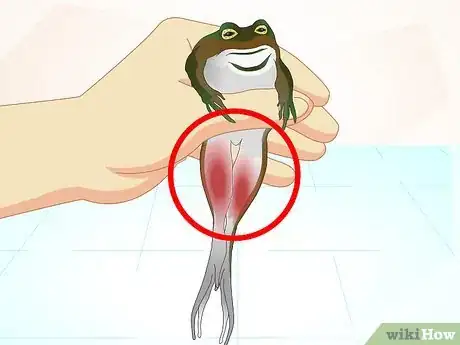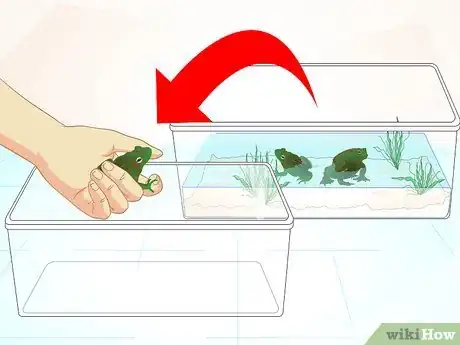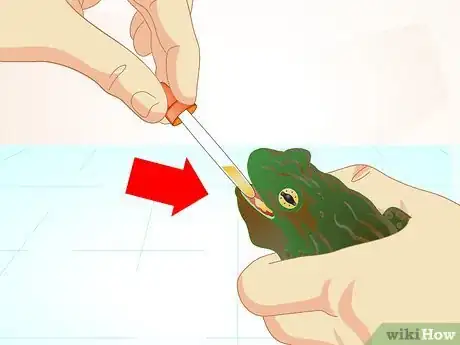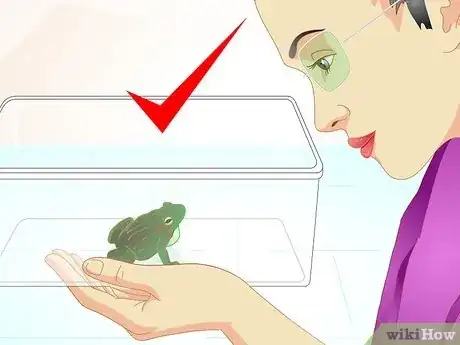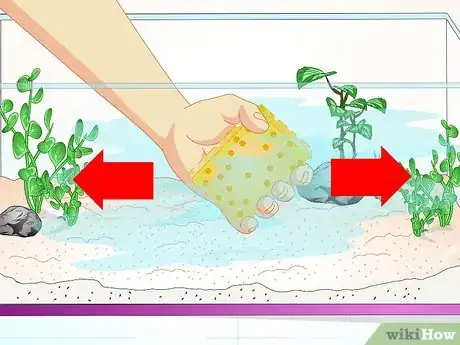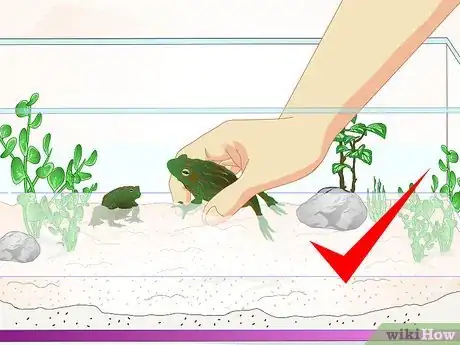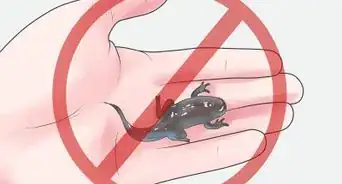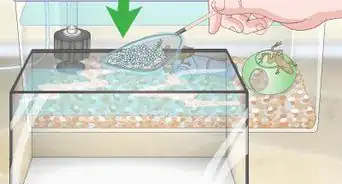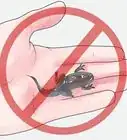This article was co-authored by Pippa Elliott, MRCVS. Dr. Elliott, BVMS, MRCVS is a veterinarian with over 30 years of experience in veterinary surgery and companion animal practice. She graduated from the University of Glasgow in 1987 with a degree in veterinary medicine and surgery. She has worked at the same animal clinic in her hometown for over 20 years.
This article has been viewed 63,293 times.
Frogs can be interesting and enjoyable to keep as pets. However, frogs are also quite sensitive and can fall ill easily. Red leg disease is one such illness that your frog may suffer from. In many cases, treating red leg disease can be difficult. Because of this, prevention is the best method of caring for your frogs.
Steps
Identifying Red Leg Disease
-
1Look for signs of lethargy. You may notice your frog acting tired or being inactive if they are suffering from red leg disease. Always monitor your frog's level of activity to learn what is normal for them, allowing you to detect any signs of illness. If you think your frog isn't as active as it normally is, you may want to take it to your veterinarian to check for any medical problems.[1]
- Frogs with red leg diseases will move very little throughout the day.
- In the later stages of red leg disease, your frog may become nearly totally inactive.
-
2Check for weight loss. One symptom of red leg disease is pronounced weight loss. Any frog that you care for which suddenly begins losing a large amount of weight is likely ill and may be suffering from red leg disease. Frogs that are displaying sudden weight loss should be brought to a veterinarian as soon as possible to look for the cause.
- Red leg disease causes your frog to almost entirely stop eating.
- However, your frog may have stopped eating for another reason. Your veterinarian will be able to tell you more.
Advertisement -
3Identify any bleeding or sores. Red leg disease can cause bleeding and open sores to occur in your frog. Displaying open sores or bleeding is a serious sign that an infection has progressed to a very dangerous point. Immediate veterinary attention is required if your frog is showing these signs as it may be near death at this point.[2]
-
4Look for red legs. The easiest way to identify a possible case of red leg disease is to look for the reddening that the disease gets its name from. The underside of your frog will begin to turn a shade of red, due to an internal infection. As soon as you notice any signs of reddening in the legs or underside of your frog, take them to your veterinarian for treatment.[3]
- You may first notice the redness in the tips of the frog's toes.
- The red legs appear because the capillaries in the frog's legs are dilated.
Dealing With Red Leg Disease
-
1Take your frog to your veterinarian. If you suspect that your frog may be ill or suffering from red leg disease, you will want to take them to your veterinarian as soon as possible. Your veterinarian will be able to accurately diagnose the problem and learn if your frog has red leg disease. They will also be able to prescribe treatment and medications that you can use to help your frog recover.
- Red leg can be caused by bacterial or fungal infections. You veterinarian will be able to determine the exact cause.
-
2Keep your frog away from others. Red leg disease is contagious and you will need to keep it from spreading to any other frogs you might care for. It is important that you keep your infected frog in another tank, away from other frogs that have not yet contracted red leg disease. You will also want to clean any tanks or equipment that the infected frog was using to cut down on the risk of red leg disease spreading.
- You may also be instructed to give medication to your other frogs as a precaution.
-
3Administer medications. If your frog was found to have red leg disease, your veterinarian may have prescribed antibiotics or other treatments that will destroy the bacteria or fungus responsible for red leg disease. You will be required to give these medications to your frog according to the exact instructions your veterinarian gives you.
-
4Monitor your frog. Once your frog has been to the veterinarian, separated into a clean environment of its own, and antibiotic treatment has begun it's time to let your frog heal. This will be a period of waiting and watching, taking careful note of your frogs condition and behaviors. Try not to bother your frog during this time any more than is necessary, reducing stress levels and allowing them to heal more quickly.
- Leave your frog alone to recover and keep disturbances to a minimum.
- Check in on your frog often to look for signs of improvement.
- It should take two or three weeks for your frog to recover.
Preventing Red Leg Disease
-
1Feed your frog properly. A proper diet and feeding practice can be one way that you can help your frog to stay healthy and avoid any illnesses, such as red leg disease. The best diet for your frog will vary from species to species. However, there are some basic tips that you can use to make sure your frog is eating properly.
- Crickets are often fed to frogs. Dusting crickets with calcium powder can be a good way to boost nutrition and avoid other diseases.
- Frogs can also eat worms such as night crawlers. You can find these yourself or buy them from a pet or fishing store.
- Large frogs can sometimes eat mice. However, mice should be offered rarely as they are highly fattening.
-
2Keep a clean environment. Frogs require a great deal of care and cleanliness when being kept in any kind of indoor environment. You will need to make sure the frog's environment is kept as clean as it can be to lower the chances of your frog suffering from red leg disease and other infections. [4]
- Always keep water in the enclosure clean and dechlorinated. Water should be changed everyday.
- Never leave spoiled food in the enclosure. Remove any uneaten items immediately.
- Regularly clean the entire enclosure.
-
3Provide a proper environment. Part of properly caring for a pet frog is giving them a safe and comfortable environment to live in. Improperly arranged environments can increase stress in your frog and expose them to a higher risk of contracting red leg disease. Make sure your frog's environment meets the following needs of your frog:[5]
- UV lighting can give your frog the health benefits that exposure to sunlight would bring.
- Humidity will need to be maintained at a level appropriate for your species of frog.
- Keep the temperature at an appropriate level for your species of frog by using a light or heating pad.
- Avoid over crowding. Having too many frogs may increase stress levels and allow diseases to spread more quickly.
Warnings
- Prevention is your best course of action. Red leg disease is often deadly in frogs and difficult to cure.⧼thumbs_response⧽
References
- ↑ http://ilarjournal.oxfordjournals.org/content/48/3/235.full
- ↑ http://ilarjournal.oxfordjournals.org/content/48/3/235.full
- ↑ https://kb.osu.edu/dspace/bitstream/handle/1811/5136/V66N01_087.pdf;jsessionid=2C6D21C3B163BD5480637F51EBF59E47?sequence=1
- ↑ http://ilarjournal.oxfordjournals.org/content/48/3/235.full
- ↑ http://ilarjournal.oxfordjournals.org/content/48/3/235.full
About This Article
If you've noticed symptoms of red leg disease in your frog, like lethargy, weight loss, bleeding, open sores, or red-colored legs, take it to the vet as soon as possible for treatment. Your vet will determine whether the disease was caused by a bacterial or fungal infection, and then they'll prescribe the right medication depending on the cause. Once you bring your frog home, give it any medications your vet prescribed, and keep it away from any other frogs you have so it doesn't get them sick too. Let your frog rest while it recovers, and check on it every once in a while to see if it's improving. If your frog isn't recovering after 2-3 weeks, reach out to your vet for advice. For tips from our Veterinary co-author, like how to prevent red leg disease, keep reading.



